#our correspondents have reached out to experts for their input. this is a developing story
Explore tagged Tumblr posts
Text
pretty much all xiyao shippers the second wangx!an and xiyao ended up in the same bracket of the latest poll tournament: well we're definitely gonna lose this one since who can really compete with the main ship in a competition like this, but oh well, let's have fun with it anyway
some rabid wangx!an shippers, who apparently just love hating the things that other people like:

anyway, reality check that this 👇👇👇 is what we look like when we act 👆👆👆 like that:

#salty peak sect 🧂#breaking news: the overwhelmingly popular main wins ship tournament against other side and non-canon ships#local killjoys are ecstatic over their totally precedented win and decide to piss in the cheerios of complete strangers in celebration#witnesses report asking themselves why we aren't past this kind of mean-spirited behaviour#our correspondents have reached out to experts for their input. this is a developing story
14 notes
·
View notes
Text
Deeper evaluation of Plant.id
Plant.id is a plant identification service powered by deep convolutional network model. We created plant.id to give access to the cutting edge machine learning technology accessible through the web app for people for free and through API for commercial use.
Proper evaluation of performance and selection of results can be tricky because one number never tells the whole story. Depending on the application of the model we are interested in different properties of model’s predictions. So, let’s delve deeper into the data and evaluate model from various points of view.
Task
First of all, let’s define the problem.
Input
images - a set of plant photographs; in most other applications only one photo is available, however we are able to identify from multiple photos
date - day when images were taken
location - a coarse GPS coordinates where plant photos were taken
Output
predictions - for each class (plant taxon) probability that the plant is a member of the class
suggestions - in reality final output of the model is a list of classes with the highest probabilities. List’s length can vary based on confidence of the model
Our model currently works with 10997 classes, each one represents either plant species (e.g. Anemone drummondii) or less often plant genus (e.g. Anemone). The dataset includes mostly vascular plants (including trees and shrubs); bryophytes, fungi and lichens are also covered. Together with the identified name, Plant.id also returns a representative image of the taxon, carefully selected based on the similarity to the input image (typically the same organ and development phase). However, this process is not a part of this evaluation.
Selection of the Suggestions
In practice, we offer multiple suggestions so user can choose from more options. Under the hood the models create dozens of suggestions. The exact number of predictions depends on the overall confidence of the model, number of images etc. The graph below shows the distribution of suggestion count:

Clearly, having too many suggestions is not practical. And most of them have likely a very small confidence anyway. This is why we have to reduce their number.
We evaluate two strategies of limiting the number of suggestions:
Top k - one way is take only the k best predictions (those with highest probabilities).
Minimal probability - other way is to take those predictions which are good enough, i.e. those predictions with probability larger than a threshold t.
The first approach is simpler, but the second one is more adaptive. For instances with high confidence we present only a small number of suggestions. On the other hand, when the confidence level is low (meaning that no classes have high probability) we present more options to select from.
Data
The primary source of data was FlowerChecker. It is a long-established plant identification app where plants are identified by an international team of experts with decades of experience and a broad range of specialities. We included all successfully identified plants between 2019-01-01 and 2019-07-16, totaling in 16.905 plants of different 3917 taxa. We admit there are occasional misidentifications, however, most plants were checked by multiple botanists which gives us confidence in the quality of our data. On average, botanists are not able to identify ~15% of plants. In most cases, it is because of the quality of images or the state of a plant. It is also partly because people often send to FlowerChecker tricky plants. It is because they are often satisfied with the results of automatic recognition apps such as Plant.id when identifying easy plants such as common indoor or garden plants and do not seek professional advice any more.
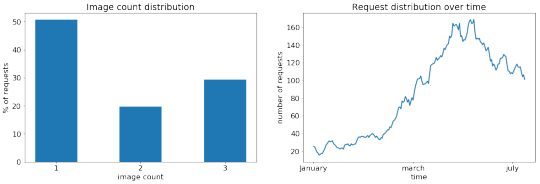
The map shows the geographical distribution of requests in the dataset:

Note that our training dataset and testing datasets consist of different plant images.
Cover
The model coverage is limited by 10.997 classes (taxa). The experts identified 8.27% plants that were new (unknown) to the model. Therefore, the theoretical maximum of the success rate was 91.73%.
Accuracy
The most straightforward metric of success is accuracy. If we considered the single top prediction, the accuracy was 61.1%. Keep in mind that the theoretical maximum was 91.73%. It means that the correct answer of the model was roughly in 2 out of 3 cases.
Next, we evaluate the accuracy of approaches which select multiple suggestions. In this context identification is successful if the correct answer is among suggestions.
Top k
This graph shows how well the model performs for top k predictions.
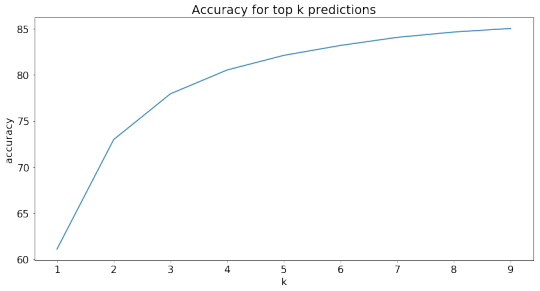
To be specific, the accuracy was as follows:
77.9% for the top 3 predictions
82.1% for the top 5 predictions
85.5% for the top 10 predictions
88.4% for all predictions (we call this metric listed accuracy)
Minimal probability
First of all, we have to determine what probability threshold choose? Here is how is the threshold related to the average number of suggestions and accuracy.
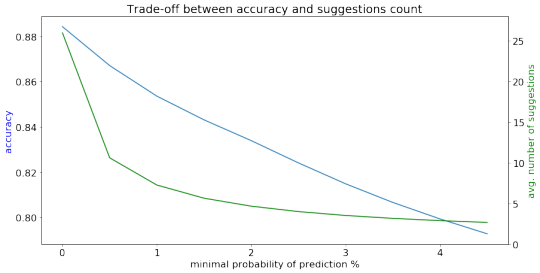
This gives us a convenient area when suggestion count is reasonable and accuracy is still high enough. For both evaluation and production we use threshold 1% and we present only predictions with higher probability.
With this threshold, the** accuracy reaches 85.3% **(we report this value as success rate) and average number of suggestions 7.3. If the average is not good enough for you, here is the whole distribution:
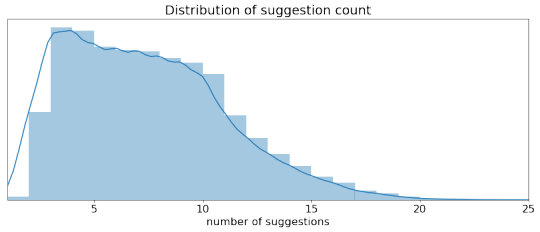
Rank distribution
Another way how to assess the performance of the model is focusing on positions (ranks) of the ground truth (correct answer) between predictions:
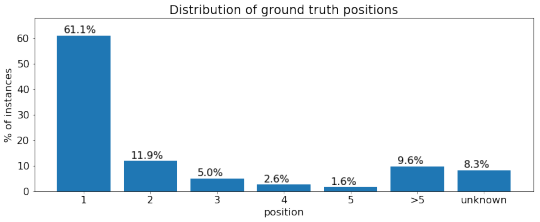
Mean Reciprocal Rank
Mean Reciprocal Rank or MMR is a different metric which takes into account all predictions and looks at what is the position of the correct answer. If on the first position, we get 1 point, if on the second position, we get ½ point, if on the n-th position we get 1/n point. No correct answer listed is 0 points. Afterwards, MMR is point averaged over identifications, 1 one is the best score and 0 is a theoretical minimum. MMR of our model equals 0.703.
Only known plants
As we mentioned, the model knows only 91.73% plant classes. If we narrow down the calculation only to this subset, we get the following results:
top 1 accuracy: 66.6%
top 5 accuracy: 89.5%
top 10 accuracy: 93.1%
listed accuracy: 96.6%
probability > 1% accuracy: 93.0%
MMR: 0.766
Impact of image count and cropping
To improve the accuracy of the model, we create multiple clippings from the original image and for each clipping, we make a prediction and combine them together. In this report, we use** 5 clippings **which seems to be a suitable compromise between accuracy and processing time. However, in the API, we offer several options.
Here, we provide a comparison of the default model setting evaluated above with the model setting using only the first image or a different number of clippings.
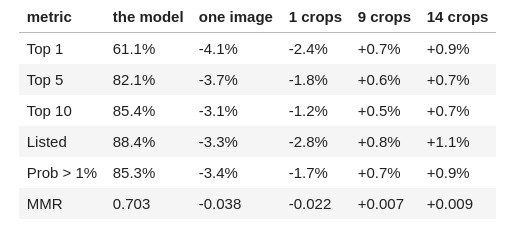
CLEF
As an alternative source of data for the evaluation, we used PlantCLEF 2017 test dataset. There are 25,170 images in 1125 classes. Compared to our dataset, 133 classes are not covered by our model and these classes create 6.7% of CLEF images. For this evaluation, we used the same metrics as in the CLEF challenge and measured the model in three modes:
as is - we used all predictions of the model
relevant predictions - we used only predictions of our model which correspond to relevant 1125 classest, i.e. we ignored predictions not useful for CLEF challenge
known classes - finally, we used only those images (93.3% of data) for which a class is known by the model
Compared to CLEF, our model is trained with different data with almost ten times more classes. Therefore a direct comparison of our model with CLEF participants is not possible, however results above suggest that it is at least comparable with top CLEF participants.

See also independent academic study: Artificial Intelligence for plant identification on smartphones and tablets.
1 note
·
View note
Text
6 Things You Need to Know About the Book Editing Process
Although editing a book is an extremely demanding process, it can be simplified using an exact procedure. Writers are often susceptible to overlooking errors; for this reason, one must make a mental map to review their content. Having a clear mindset, without any predetermined judgement, facilitates the process of editing. As a writer, one must begin by outlining what needs to be edited and in what order. The essence of one’s story structure, plot and characters should not be altered in the book editing process.
Every day a vast number of books are published. For a book to stand at par with the most excellent books ever published, it must be extraordinarily engaging and should appeal to readers. With every edited draft, a story gains more clarity within itself; hence, a writer must expend as much energy in editing a book as she or he does in writing one.
Here are six things you need to know about the book editing process to make your book more engaging.
1) Types of Editing
A manuscript must be subjected to various edits and corrections before it reaches the final draft since there are numerous types of editing involved.
However, the first step is always to set aside your manuscript for a few days after it is complete. Many renowned authors have adopted this approach. Stephen King once claimed that he does not look at his manuscripts for at least six weeks after completing it. This process helps in rearranging your thoughts in a manner that when you finally pick up your manuscript, you approach it as a reader would.
Once you gain an objective outlook toward your manuscript, it is important to expose it to two types of editing, i.e., structural and copy editing. Structural editing involves polishing the spine of the story by improving the plot, conflict and theme of the book. On the other hand, copy editing primarily includes narrowing down on which style guide to use.
As we proceed, you will learn about these editing processes in detail.
– Structural Edit: Structural editing sheds light on developing the concept of the book. It includes analyzing the manuscript to ensure a consistent and fundamental flow in the point of view, tense, plot, subplots, and dialogue. It is at this point that one reassesses the importance of the individual elements in the narrative and takes a call on whether to sustain or remove these elements. In structural editing, the focus is on literary devices such as pacing, character development, plot, writing style, and setting.
– Plot editing: This type of editing sheds light on the intensity of significant plots in the story and their potential to drive the tension throughout the narrative. It is essential not to have scenarios that are too predictable since plots with a surprise element tend to hold the attention of the reader. Every scene must drive the story forward.
– Conflict and theme editing: It highlights the overarching theme of the book and how the conflicts in between chapters of the story build its backbone. The aim here is to ensure that each conflict and the overall theme of the story complement the book as a whole, and contribute to keeping the reader engaged. When hiring a professional, then the author and the Developmental editor must collaborate to shape the manuscript into the final draft. This stage requires a lot of patience as it takes time for the editor to respond to the suggestions and inputs of the writer. Keep the communication clear in terms of the essential elements of the story as it will ensure a consistent setting and timeline of your plot. The structural editing process can be carried out in the initial stage of the publication process, i.e., the drafting stage of a book.
– Copy Edit: Copyediting is carried out once the manuscript is completely organised. It includes a word by word editing of the book and looking over punctuation, capitalisation, spelling, abbreviations, grammar and any other style rules. To carry out the same, it is imperative to select a Style Guide for the language format and guidelines for your book. The three most popular style guides are the Oxford style guide, the Economists style guide and the Chicago manual of style. The Oxford Style Guide is the university style guide and is mostly meant for use and reference for University publications. It is one of the most revered style guides for the usage of UK English. The Economist Style Guide is the language framework used for the British newspaper, the Economists. Even though the style guide was initially supposed to be restricted to Journalism, it has been adopted by various writers as well. This style guide focuses more on interesting content rather than description and narrative. The Chicago Manual of Style is one of the most used style guides for American English. This style guide was published by the University of Chicago Press and is extensively used for fiction and non-fiction publications in the USA and elsewhere.Copy editing essentially involves checking for errors in word usage to ensure the content has the necessary and accurate citations, references, notes, tables, figures and charts.
2) Editing scene by scene
After editing the structure and the language of the book, the next step is to bring your attention to the scene by scene edit of the whole book. Scene-by-scene editing is determined by the flow in which conflict and respite are placed in the story. It includes focusing on transitions between characters, chapters and the story itself. In this stage of editing the most important question one must keep asking is; does each scene move the story forward?
Highlight the three-act structure of your story, i.e., setup, conflict and resolution to ensure that it corresponds with the sequence of events within the story.
All computers have a feature available that enables one to hear out their manuscript. Mac users can go into system preferences to choose a system voice and speaking rate for the selected text. PC users can utilise the Narrator feature available in the system’s Ease of Access Center.
3) Editing of dialogue
This process includes delving into editing the dialogues of your book with an extremely objective approach. When going over the dialogues, it is crucial to question how each dialogue is contributing to not only the story but also the weight of the character saying it. Beware of insignificant and repetitive dialogues that seem to appear normal since they might be a part of our daily speech, however, if in the flow of your story, it doesn’t add much to the scene consider revising it.
More than being a functional tool, dialogues are at the crux of compelling storytelling.
4) Final proofreading before design
Proofreading is carried out only after the raw manuscript has already been edited. It is the last stage of the editorial process before the book is designed and sent to distributors. It involves analysing the final manuscript to check for any additional typographical errors, irregularities in the fonts used, incorrect lines, words, or page spacing.
This step eliminates any issues regarding misnumbered listicles, page headers, footers and page numbers. One must also look for any page break problems like widows and orphans as it helps in avoiding any unwanted word splits at the end of a line. It is highly recommended that proofreading is carried out once again after the book has been designed.
5) Cost & time for editing a book
The editorial process could be extended, depending on the word count, type of editing required, amount of editing. Extending from before the completion of the manuscript through proofreading of the final page proofs.
Structural editing takes the longest since it includes resubmissions and a comprehensive discussion with the editor to get the best results. The overall process could take around 4 to 6 months, and differ as per the word count. Copy editing your book could take 4 to 7 weeks. The proofreading process is a lot quicker, which takes around 2 to 4 weeks. Create a timeline for when you want to publish your book according to the editing process.
Some publishers include editing in the publishing package, which makes the process of editing hassle-free.
6) To Hire or Not Hire a Professional
It is important to identify the need for a professional editor. If one is hugely novel to this process, it is advisable to take help from a professional as they identify technical errors in utmost detail.
To publish a great book, it is vital to have a professional with an unbiased opinion. One must hire an editor who is proficient at making the content crisp, concise and grammatically correct. A professional editor can give expert inputs on the structure, style and syntax and helps in speeding up the process of editing.
Good editors are pivotal in making a book great. To ensure the editors are on the same page as you, select someone who thoroughly understands the process and the essence of your plot. Someone who is not emotionally invested in your book will give great objective advice. This will ensure that you are publishing the best version of your book.
0 notes
Text
Oman Vision 2040: Defining Future Goals
Oman 2040 is a national project that aims to create an insightful vision that foresees the future and strives for more progress and development, aligned with an ambitious work system that all social segments participate in formulating, in order to define the Sultanate’s future goals and map out the action plan and implementation and conceptualisation mechanisms until 2040.
Read also: Fedex Express Expansion Aligns with Oman Vision 2040
The process of preparing the Oman 2040 Future Vision relies on a number of basic premises including: National Priorities, Report on Main Directives to Formulate Oman 2040, the National Program for Enhancing the Economic Diversity (Tanfeedh), outputs of the Oman 2040 committees and task-forces, available studies and strategic reports, Oman 2020 achievements and lessons learned, UN Sustainable Development Goals 2030, sectoral strategies, National Strategy for Urban Development, Ninth Five-year Development Plan, international reports and indicators related to the Vision pillars, and the outputs of Oman Vision 2040 Office.
The blueprint
The strategy, first unveiled last year, seeks to catapult the Sultanate into the ranks of the world’s most ‘developed nations’. The blueprint targets economic growth of around 5 percent annually over the 2021 — 2040 timeframe.
This compares with average growth of 7.5 per cent during the 1970 – 1995 period, and corresponding average estimated growth of 3.5 per cent during the 1995 – 2020 span.
Read also: Oman has achieved 70% of 2020 vision goals: SCP Secretary-General
The Vision 2040 strategy represents the essence of a four-year-long exercise during which the task force reached out to an estimated 40,000 Omanis — young and old — as well as entrepreneurs, business persons, experts and professionals.
This Vision has been formulated based on inputs from Omani individuals, businesses and stakeholders representing all facets of Omani society. It encapsulates Oman’s current realities and future opportunities, and leverages our competitive strengths and advantages.
It enables the Sultanate to move the next stage of development which is based on a different set of engines — digitalisation being one of them.
The blueprint seeks to capitalise on the building blocks of Oman’s modern renaissance characterised by its positive development story and excellent infrastructure represented by the nation’s high-quality roads, airports and seaports.
Most importantly, it will seek to leverage Oman’s modern appeal as a stable nation – a legacy of His Majesty the Sultan’s wise leadership, and its friendly policies that have enabled the Sultanate to forge strong bilateral ties with countries across the world, and integrate with the global economy.
The estimated 50,000 young Omanis entering the labour market every year, when suitably trained and developed, would help in the achievement of the Vision 2040 goals. These young Omani students represent 50,000 engines of growth.
Among the 69 Key Performance Indicators (KPIs) that must be met to achieve the Vision 2040 objectives are a number of economic targets. They include a commitment to raise Real GDP per Capita by 90 per cent, Real GDP Growth by 5 per cent annually, and the contribution of Foreign Direct Investment (FDI) to GDP to 10 per cent. Furthermore, it envisions the share of nonoil activities to grow to more than 90 per cent of GDP, as well as a 40 per cent contribution to job creation by the private sector.
A key objective of the strategy is to support the development of a competitive economy.
The strategy also looks to make the business environment attractive to foreign investment. This is a key goal of Vision 2040.
IMF: Oman’s Economy Gradually Recovering
The post Oman Vision 2040: Defining Future Goals appeared first on Businessliveme.com.
from WordPress https://ift.tt/33R92V6 via IFTTT
0 notes
Text
A Future Of J.D. Advantage Jobs?
It’s been a lucrative year for legal tech. We’re closing in on $1 billion in investment for 2018 with significant capital contributions from high-flying investors like Mark Cuban (undisclosed investment in pro bono facilitator, Paladin), Kobe Bryant ($500 million financing round in LegalZoom from his fund and others) and Justin Kan (raised $65 million for legal start up, Atrium).
That’s just naming a few.
These are big, financial wins for the legal entrepreneurs building the companies now set to reshape the legal services industry. But, they’re also equally big wins for those “misfit” lawyers and law school graduates who increasingly find themselves disillusioned with traditional practice – veering towards a new category of “J.D. Advantage” jobs for which a law degree is strongly preferred, but not necessarily required.
Might the future be in fact filled with J.D. Advantage jobs?
Here are a few worth pondering.
Director of Legal Technology Sales Starting Salary: $110,000 + Commission
Venture firms wouldn’t be going in on legal tech to the tune of millions of dollars if they didn’t expect see 5x to 10x returns on investment. The pressure to “sell, sell, sell” legal tech solutions will lead to the rise of the new J.D. preferred Director of Legal Technology Sales role.
Increasingly, legal tech sales are driven by demand from lawyers as opposed to non-lawyers. This is especially true in B2B markets and belies the conventional headline that technology will replace lawyers by selling solutions to those without law degrees. More and more solutions are being consumed by law firms and in house counsels looking to boost competitiveness. Who better to sell legal tech to lawyers than other lawyers?
Enter the Director of Legal Technology Sales role, responsible for legal tech solution selling and strategy. Tasks for this role include presenting sales materials to potential legal client customers, leading product demonstrations, Q/As and providing critical feedback back to internal engineering teams for product enhancement. A J.D. is preferred for the Director Legal Technology Sales who must properly evaluate the practicality of tools designed to improve some aspect of legal services and establish credibility in product pitches to potential legal customers.
Ethical A.I. Designer & Manager Starting Salary: $250,000
Artificial Intelligence solutions have entered the legal market and are being deployed to automate many aspects of practice. Of the almost $1 billion in new legal tech investment raised this year, roughly half ($355 million) has gone to Legal A.I. ventures.
Legal A.I. is busy becoming competent at many traditional legal tasks (like contract review, document drafting and due diligence). However, it still requires an experienced attorney to program, manage and correct it along the way. There also remain legitimate questions as to whether a software system can ethically practice law if not under the supervision of an attorney. For these reasons, we’ll need to recruit, hire and train for a new, highly specialized role tasked with designing and watching over Legal A.I.
The Ethical A.I. Designer & Manager will advise and supervise machine learning teams working on Legal A.I. projects. They will act as subject matter experts, helping engineers identify the proper inputs and workflows to ultimately apply this powerful new automation technology to live practice. Post deployment, they will work with customers on A.I. implementation and practice integration, and manage and correct any errors made by the Legal A.I. system to ensure its continual learning and development.
Public and private entities will be tempted to apply A.I. to dispute resolution, leading to the emergence of “Smart Judges” and “Automated Arbiters” issuing A.I. supported legal opinions and formal dispositions. This is why it’s especially critical for Ethical Legal A.I. Designer & Managers to be well-versed in the ethical rules of legal practice.
Chief Innovation Officer (Law Firm or Law School) Starting Salary: $180,000
Recent investments in legal tech will rapidly accelerate innovation, as well as the need for both law firms and law schools to undergo both “digital” and “cultural” transformations to keep pace with consumer trends.
No law firm will be immune to disruption. As pointed out by legal futurist Richard Susskind in Priori’s recent interview, smaller firms will “struggle for survival” in the short term unless they “radically change what they do.” Medium and large firms also face brutal competition with alternative legal service providers, like Priori, and the Big Four accounting firms. The pressure on law schools to evolve for their very survival is similar. Law schools failing to adequately prepare students for the future through innovative coursework and technical work-study programs will watch employment figures decline, along with applications.
The crucial role, therefore, of the Chief Innovation Officer is to ensure the needed organizational transformations take place, including both digital and cultural changes. This demands critical examinations and the identification of strategic projects designed to ensure long term success. Examples on the “digital” side may include implementation of enhanced knowledge management and work collaboration platforms. On the “cultural” innovation side, it may include a new talent acquisition strategy, promoting diversity efforts, and social media engagement. The Chief Innovation Officer must also be intimately familiar with the latest products and solutions offered by competing organizations to ensure strategic competitiveness in the rocky years ahead.
Virtual Courtroom Designer
Starting Salary: $90,000
Lastly, the future of justice is looking virtual. Online dispute resolution platforms and courts are on the rise.
We recently learned that they’re the subject of Richard Susskind’s next book. Susskind predicts that 15 years from now our courts will be “changed beyond recognition.” We’re already seeing legal tech start ups attacking the larger social problem of the high cost of dispute administration and resolution. Take for example, FairClaims, the downtown LA based start up offering a vastly cheaper means to resolve small claims disputes through an online portal. The ability to one day integrate virtual courts with legal practice dashboards like Practice Panther and Clio will further reduce the need for physical congregation in actual reality (“AR”) courts, providing compelling incentives for public and private institutions to experiment with and one day implement online dispute resolution portals.
Designing our virtual courts of the future will not be left entirely to user-experience (or “UX”) designers and “VR artists” without law degrees. Virtual Courtroom Designers with J.Ds will be responsible for ensuring online dispute resolution platforms retain the essential characteristics of due process, including proper evidentiary and civil procedure rules. They will also be tasked with collaborating with VR artists directly on re-creating a virtual court system consistent with modern legal norms and advising on any applicable State or Federal requirements.
A Future Full of J.D. Advantage Jobs?
The sizable legal tech investments we’re seeing in 2018 are likely to continue for many years to come, accelerating the advent and adoption of many new types of law jobs. Many of these new jobs I predict will be in the form of J.D. Advantage jobs.
The more I think about it, the more plausible it seems that the legal services industry will soon see more law school graduates working in J.D. Advantage jobs as opposed to practicing as traditional licensed attorneys.
The end result may be an advantage to all of us.
Ian Connett, Esq. (@QuantumJurist) is the Founder of QuantumJurist, Inc., a LegalTech consulting and technology venture dedicated to improving and creating efficiencies in the legal services industry. Ian is also a Contributing Editor to the EvolveTheLaw.com Legal Innovation Center and Host of the Evolve the Law Podcast. Ian resides in New York, where he has served as an in-house counsel to numerous technology companies. You can connect with Ian on Twitter and LinkedIn and you can reach him by email at [email protected] (for story ideas, personal correspondence, media inquires or speaking engagements).
A Future Of J.D. Advantage Jobs? republished via Above the Law
0 notes